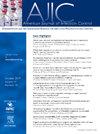Evaluation of Certification Board of Infection Control and Epidemiology, Inc Certification in Infection Control (CIC) examination rates
IF 3.8
3区 医学
Q2 INFECTIOUS DISEASES
引用次数: 0
Abstract
Background
Infection prevention professionals develop through training and certification practices, with the Certified in Infection Control and Epidemiology (CIC) exam being the industry standard for infection prevention and control expertise.
Methods
This study conducted a secondary analysis of Certification Board of Infection Control and Epidemiology, Inc exam scores from 2013 to 2022. Reliability coefficients, Spearman-Brown coefficients, and Standard Error Measurement averages were calculated for the CIC exam’s eight objective areas from 2016 to 2022.
Results
Over the past decade, pass rates varied from 57.30% to 85.40%, with a mean of 69.7%. The number of exam participants ranged from 574 to 1,392. Despite the variability, the highest reliability, Spearman-Brown, and Standard Error Measurement averages were consistently observed in areas such as identifying infectious disease processes, surveillance, epidemiological investigation, and controlling transmission of infectious agents.
Conclusions
As more facilities push for certification, the number of CIC exam takers has increased. However, the evolving nature of infection prevention and the lack of a standardized training track contribute to variations in reliability coefficients across the exam's objective areas.
感染控制和流行病学认证委员会评估。感染控制(CIC)检查率认证。
背景:感染预防专业人员通过培训和认证实践来发展,感染控制和流行病学认证(CIC®)考试是感染预防和控制专业知识的行业标准。方法:本研究对2013-2022年感染控制与流行病学认证委员会(CBIC)考试成绩进行二次分析。可靠性系数、Spearman-Brown系数和标准误差测量(SEM)平均值计算了2016-2022年CIC®考试的八个目标领域。结果:近十年来,通过率为57.30% ~ 85.40%,平均为69.7%。参加考试的人数从574人到1392人不等。尽管存在差异,但在识别传染病过程、监测、流行病学调查和控制传染病传播等领域,始终观察到最高的可靠性、Spearman-Brown和SEM平均值。结论:随着越来越多的机构申请认证,参加CIC®考试的人数也在增加。然而,感染预防的不断发展和缺乏标准化的培训轨道导致了考试目标领域的可靠性系数的变化。
本文章由计算机程序翻译,如有差异,请以英文原文为准。
求助全文
约1分钟内获得全文
求助全文
来源期刊
CiteScore
7.40
自引率
4.10%
发文量
479
审稿时长
24 days
期刊介绍:
AJIC covers key topics and issues in infection control and epidemiology. Infection control professionals, including physicians, nurses, and epidemiologists, rely on AJIC for peer-reviewed articles covering clinical topics as well as original research. As the official publication of the Association for Professionals in Infection Control and Epidemiology (APIC)

 求助内容:
求助内容: 应助结果提醒方式:
应助结果提醒方式:


